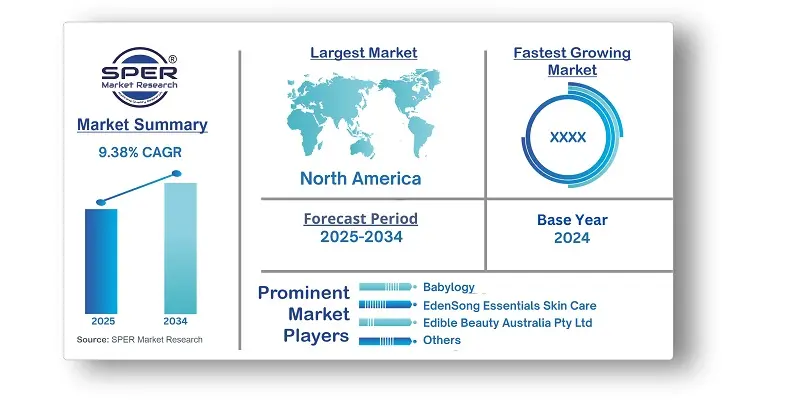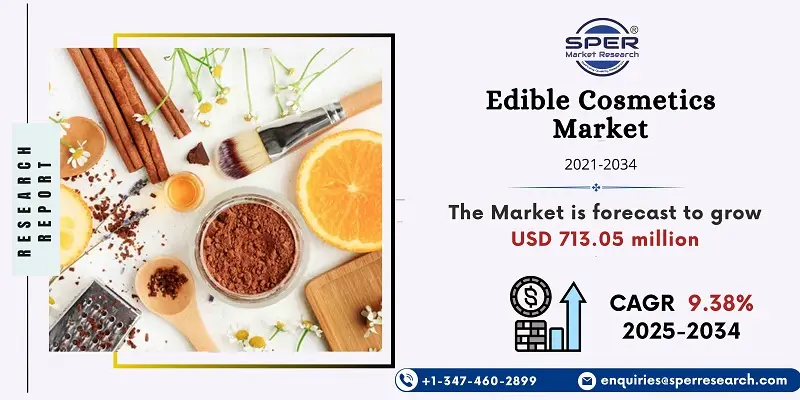Global Edible Cosmetics Market Introduction and Overview
According to SPER Market Research, the Global Edible Cosmetics Market is estimated to reach USD 713.05 million by 2034 with a CAGR of 9.38%.
The report includes an in-depth analysis of the Global Edible Cosmetics Market, including market size and trends, product mix, Distribution Channels, and supplier analysis. The global edible cosmetics market is growing as consumers seek natural, chemical-free beauty products that are safe for both skin and ingestion. These products, made with organic, food-grade ingredients, align with the rising demand for clean beauty and sustainability. Edible cosmetics include skincare, lip care, and hair care items formulated without synthetic additives, appealing to health-conscious consumers. Key drivers include increasing awareness of toxic-free beauty, the trend toward organic and vegan products, and the influence of social media and celebrity endorsements. However, challenges such as high production costs, shorter shelf life, and regulatory complexities in different regions can hinder market growth.
By Product Insights
The product segment of the edible cosmetics market is categorized into four categories: Skin Care, Hair Care, Makeup, Nail Polish. Edible skin care cosmetics made up a prominent part in 2024. These products appeal to consumers looking for natural and organic components, as they offer a safer and more environmentally responsible alternative to typical cosmetics. The convergence of beauty and wellness themes has increased the popularity of edible skin care products. Demand for edible nail polish is expected to rise from 2024 to 2030. The demand for edible nail polish is expected to increase due to rising customer demands for safe and non-toxic beauty products, particularly for youngsters.
By Distribution Channel Insights
The distribution channel segment of the edible cosmetics market is categorized into five categories: Hypermarkets & Supermarkets, Specialty Stores, Pharmacies & Drugstores, Online and Others. In 2024, edible cosmetics sales in hypermarkets and supermarkets accounted for a large market share. Hypermarkets and supermarkets are emerging into recognized beauty product destinations, with a diverse selection of skincare and cosmetics. Online sales of edible cosmetics are predicted to increase from 2024 to 2034. The e-commerce segment of the cosmetics business is fast growing due to the ease of online purchasing, which allows consumers to browse a wide choice of beauty items from the comfort of their own homes.
By Regional Insights
North America presently leads the edible cosmetics industry, which is being pushed by a combination of customer preferences, technology improvements, and market dynamics. Consumers in the region place a high value on health and wellness, and they are increasingly looking for products that use natural, safe components. This choice has considerably increased the market for edible cosmetics that provide both beauty and nutritional value.
Market Competitive Landscape
Personalization and customisation are becoming increasingly popular in the edible cosmetics sector, as customers seek goods that are matched to their specific needs and preferences. This trend stems from a desire for one-of-a-kind beauty products that address specific skin issues or cosmetic goals. Some of the key market players are Babylogy, EdenSong Essentials Skin Care, Edible Beauty Australia Pty Ltd, HL Edible India, Kid Licks, Living Nature, Natural Organic Edible Cosmetics, Project MC2, Skin Gourmet and Skin Pot Co.
Recent Developments:
In June 2024, Skin Gourmet exhibited its new goods at the Cocoa Food Fair 2024 emphasizing cocoa's versatility in beauty and wellness. The event, part of the Netherlands Embassy's annual Orange Week in Ghana, celebrated Ghana's cocoa sector with a variety of contributions from local and international participants.
In November 2022, Live Verdure Ltd bought Edible Beauty Australia Pty Ltd. The acquisition expands the company's market footprint through its broad skincare and wellness offerings. This initiative tries to increase revenue while lowering costs, thereby improving the company's financial performance.
Scope of the report:
| Report Metric | Details |
| Market size available for years | 2021-2034 |
| Base year considered | 2024 |
| Forecast period | 2025-2034 |
| Segments covered | By Product, By Distribution Channel |
| Regions covered | North America, Latin America, Asia-Pacific, Europe,
and Middle East & Africa |
| Companies Covered | Babylogy, EdenSong Essentials Skin Care, Edible Beauty
Australia Pty Ltd, HL Edible India, Kid Licks, Living Nature, Natural Organic
Edible Cosmetics, Project MC2, Skin Gourmet, Skin Pot Co. |
Key Topics Covered in the Report
- Global Edible Cosmetics Market Size (FY’2021-FY’2034)
- Overview of Global Edible Cosmetics Market
- Segmentation of Global Edible Cosmetics Market By Product (Skin Care, Hair Care, Makeup, Nail Polish)
- Segmentation of Global Edible Cosmetics Market By Distribution Channel (Hypermarkets & Supermarkets, Specialty Stores, Pharmacies & Drugstores, Online, Others)
- Statistical Snap of Global Edible Cosmetics Market
- Expansion Analysis of Global Edible Cosmetics Market
- Problems and Obstacles in Global Edible Cosmetics Market
- Competitive Landscape in the Global Edible Cosmetics Market
- Details on Current Investment in Global Edible Cosmetics Market
- Competitive Analysis of Global Edible Cosmetics Market
- Prominent Players in the Global Edible Cosmetics Market
- SWOT Analysis of Global Edible Cosmetics Market
- Global Edible Cosmetics Market Future Outlook and Projections (FY’2025-FY’2034)
- Recommendations from Analyst
1. Introduction
1.1. Scope of the report
1.2. Market segment analysis
2. Research Methodology
2.1. Research data source
2.1.1. Secondary Data
2.1.2. Primary Data
2.1.3. SPER’s internal database
2.1.4. Premium insight from KOL’s
2.2. Market size estimation
2.2.1. Top-down and Bottom-up approach
2.3. Data triangulation
3. Executive Summary
4. Market Dynamics
4.1. Driver, Restraint, Opportunity and Challenges analysis
4.1.1. Drivers
4.1.2. Restraints
4.1.3. Opportunities
4.1.4. Challenges
5. Market variable and outlook
5.1. SWOT Analysis
5.1.1. Strengths
5.1.2. Weaknesses
5.1.3. Opportunities
5.1.4. Threats
5.2. PESTEL Analysis
5.2.1. Political Landscape
5.2.2. Economic Landscape
5.2.3. Social Landscape
5.2.4. Technological Landscape
5.2.5. Environmental Landscape
5.2.6. Legal Landscape
5.3. PORTER’s Five Forces
5.3.1. Bargaining power of suppliers
5.3.2. Bargaining power of buyers
5.3.3. Threat of Substitute
5.3.4. Threat of new entrant
5.3.5. Competitive rivalry
5.4. Heat Map Analysis
6. Competitive Landscape
6.1. Global Edible Cosmetics Market Manufacturing Base Distribution, Sales Area, Product Type
6.2. Mergers & Acquisitions, Partnerships, Product Launch, and Collaboration in Global Edible Cosmetics Market
7. Global Edible Cosmetics Market, By Product (USD Million) 2021-2034
7.1. Skin Care
7.2. Hair Care
7.3. Makeup
7.4. Nail Polish
8. Global Edible Cosmetics Market, By Distribution Channel (USD Million) 2021-2034
8.1. Hypermarkets & Supermarkets
8.2. Specialty Stores
8.3. Pharmacies & Drugstores
8.4. Online
8.5. Others
9. Global Edible Cosmetics Market, 2021-2034 (USD Million)
9.1. Global Edible Cosmetics Market Size and Market Share
10. Global Edible Cosmetics Market, By Region, 2021-2034 (USD Million)
10.1. Asia-Pacific
10.1.1. Australia
10.1.2. China
10.1.3. India
10.1.4. Japan
10.1.5. South Korea
10.1.6. Rest of Asia-Pacific
10.2. Europe
10.2.1. France
10.2.2. Germany
10.2.3. Italy
10.2.4. Spain
10.2.5. United Kingdom
10.2.6. Rest of Europe
10.3. Middle East and Africa
10.3.1. Kingdom of Saudi Arabia
10.3.2. United Arab Emirates
10.3.3. Qatar
10.3.4. South Africa
10.3.5. Egypt
10.3.6. Morocco
10.3.7. Nigeria
10.3.8. Rest of Middle-East and Africa
10.4. North America
10.4.1. Canada
10.4.2. Mexico
10.4.3. United States
10.5. Latin America
10.5.1. Argentina
10.5.2. Brazil
10.5.3. Rest of Latin America
11. Company Profile
11.1. Babylogy
11.1.1. Company details
11.1.2. Financial outlook
11.1.3. Product summary
11.1.4. Recent developments
11.2. EdenSong Essentials Skin Care
11.2.1. Company details
11.2.2. Financial outlook
11.2.3. Product summary
11.2.4. Recent developments
11.3. Edible Beauty Australia Pty Ltd
11.3.1. Company details
11.3.2. Financial outlook
11.3.3. Product summary
11.3.4. Recent developments
11.4. HL Edible India
11.4.1. Company details
11.4.2. Financial outlook
11.4.3. Product summary
11.4.4. Recent developments
11.5. Kid Licks
11.5.1. Company details
11.5.2. Financial outlook
11.5.3. Product summary
11.5.4. Recent developments
11.6. Living Nature
11.6.1. Company details
11.6.2. Financial outlook
11.6.3. Product summary
11.6.4. Recent developments
11.7. Natural Organic Edible Cosmetics
11.7.1. Company details
11.7.2. Financial outlook
11.7.3. Product summary
11.7.4. Recent developments
11.8. Project MC2
11.8.1. Company details
11.8.2. Financial outlook
11.8.3. Product summary
11.8.4. Recent developments
11.9. Skin Gourmet
11.9.1. Company details
11.9.2. Financial outlook
11.9.3. Product summary
11.9.4. Recent developments
11.10. Skin Pot Co.
11.10.1. Company details
11.10.2. Financial outlook
11.10.3. Product summary
11.10.4. Recent developments
11.11. Others
12. Conclusion
13. List of Abbreviations
14. Reference Links
SPER Market Research’s methodology uses great emphasis on primary research to ensure that the market intelligence insights are up to date, reliable and accurate. Primary interviews are done with players involved in each phase of a supply chain to analyze the market forecasting. The secondary research method is used to help you fully understand how the future markets and the spending patterns look likes.
The report is based on in-depth qualitative and quantitative analysis of the Product Market. The quantitative analysis involves the application of various projection and sampling techniques. The qualitative analysis involves primary interviews, surveys, and vendor briefings. The data gathered as a result of these processes are validated through experts opinion. Our research methodology entails an ideal mixture of primary and secondary initiatives.





































